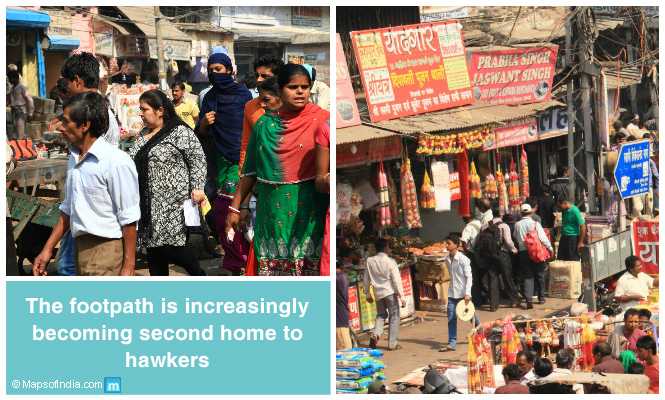Towns and cities in India are mostly unplanned and have evolved over time, with people migrating towards the more prosperous locations, in search of employment and better means of earning a livelihood.
The unchecked migration has resulted in all major metros losing their footpaths to hawkers of all kinds, who claim any available space on pathways and then begin to assert the right to hawk. The Municipal laws have been lax and political parties that control them, have mostly looked the other way, thereby ensuring that the threat of removal works as an incentive to create and hold on to vote banks.
The ultimate loser has been the citizen of that town or city, who have lost their city to hawkers and the opportunity to walk and benefit from the city that functions on their tax contribution. The fight between the walkers and the hawkers is an ongoing one, with each side having their own story and justification for asserting their right. Therefore, as citizens, it is important for us to understand positions taken by both sides before holding a justifiable perspective on the issue.
The Hawkers’ perspective
The Indian Constitution offers the right to live and work in any part of India and most states have a very lenient view on this, in the context of hawkers. Hawkers are of two categories – one which holds permission from the local municipal authority, which allows the person to sell his goods or services on the designated streets, while the other group is one that operates without any permission. The latter category is often victim of harassment from corrupt municipal corporation officials and local police, which constantly demand bribes to let them continue their trade.
It is important to understand the profile and intent of a hawker. They mostly come from poorer parts of the same state or other states, in search of a living. With little support from government sources, they mostly rely on relatives, friends and acquaintances for initial support for boarding and lodging and on their friendly advice, identify suitable locations to set up their area of operation.
Hawkers are mostly honest and simple people, with no criminal background or intent and only want to ply their trade fairly and earn an honest living. They live frugally in difficult conditions and most leave behind their families in villages. The hours put in are long and hard through all seasons in the open, this along with coping with a demanding and corrupt network of police and municipal officials, leaves most of them street hardened and over a period, street smart.
Rivalry for space is often the cause of conflict between hawkers, which sometimes turn violent. But in all this, there is no intention to disturb the local peace or bother the pedestrian, who may well be his customer. In fact in many cases, regular customers develop a friendly bond and loyalty with the neighborhood hawker and always buy from the same vendor. So, is the animosity against hawkers in general really justified, by those that walk the footpaths?
Hawkers believe they have a right to exist and operate from any designated space that is made available. Their major grievance is that all of them are ready to pay whatever taxes that is laid down, in return for a permission to ply their trade without fear or favour, since they cannot afford to buy a regular shop to run their business.
Another major complaint of the hawkers is regarding the negligence on part of the municipal authorities who tend to look away when they first set up the business and then start to harass them with the threat of eviction, when these very hawkers have established their businesses and have been operating at the same spot for years.
They do have a point. The fault lies with the political-babu nexus that exploit them for votes when it is convenient and then leave them to fend for themselves against a corrupt police, at other times.
After having operated the same business for years and at the same spot, it is indeed unfair to uproot them one fine day, without offering them a suitable and equally profitable alternate site.
Walkers’ perspective
The pedestrians have a right to the city that they live in and which they sustain, by paying their taxes. Access to the footpaths of their city is their fundamental right.
Any citizen will tell you that India has always had a ‘street bazaar’ concept, which has been around for centuries. People love the concept of walking and spending their time browsing through the collage of goods that are on sale and at bargain prices. But when it comes to the question of the footpath being overtaken by hawkers, at the cost of their freedom to move, the pedestrians are perfectly justified in opposing the presence of hawkers on the streets.
Cities like Mumbai, Chennai and Kolkata that are older cities, have been overtaken by an influx of migrants, who have taken over the streets to make a living, with many of them living on the street itself. The local residents naturally resent their presence and the fact that their space to walk being denied to them.
Both the walkers and the hawkers agree that the authorities must provide them a designated space which allows them to sell their wares. The problem has been the lack of political will on part of respective state governments and by extension, local municipal bodies, which has prevented them from taking any action on the issue that is acceptable to both sides.
Recently, there has been a lot of media attention to hawkers’ eviction in places like Pondy Bazar in Chennai, the approach road to Chembur station in Mumbai and parts of Delhi. While these have largely been welcomed by local residents, who have been relieved to get back their footpaths, the vendors are up in arms to oppose any further action on these lines. The conflict carries on.
A neutral perspective
The concept of the ‘street bazar’ in India has survived through time and is welcomed by all. It is a fact that millions in India survive by selling on the streets and therefore removal of the same may not be a desirable solution to the problem. However, two things need to be undertaken immediately. First, is to identify certain areas within each existing town and city, where Hawkers can be permitted to operate. These spaces must not be on existing footpaths but in spaces specially created for the purpose and one with facilities like toilets, etc for the vendors and public.
Secondly, future town planners may take a leaf out of this lesson and introduce well designed retail spaces with safe and easy entry/exit spaces, along with needed civic amenities like toilets, storage etc and develop this concept that is unique in function and identity to India.
These specially designated areas could be on the lines of Dilli-Haat in Delhi, a concept well received by both local citizens and international visitors. The fact that these spaces are cheap with very low maintenance cost will ensure that goods sold here remain cheap and continue to attract the same profile and number of clients, as on the streets.
Clear laws are needed for both scenarios and the same needs to be implemented vigorously otherwise the footpath will continue to remain a point of conflict, depending on which side of the footpath you are on.





